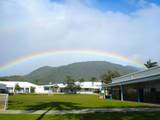Education in Dominica

Education in Dominica is compulsory from ages 5 to 16.[1] The gross primary enrollment rate was 100.4[clarification needed] percent in 1991 and 98.2 percent in 1998, and the net primary enrollment rate was 88.7 percent in 1991 and 88.8 percent in 1998.[1] Primary school attendance rates were unavailable for Dominica as of 2001. Poor physical conditions in many primary schools affect the quality of education, while some schools are overcrowded, limiting access to primary education, particularly for children living in urban areas around the capital. Poverty and work on family banana farms during the harvest season can affect school attendance, but other employment does not pull minors out of school. There is a significant Carib Indian population in Dominica and schools on the Carib Territory are reported to have fewer resources.[1]
Tertiary-level educations institutions include Dominica State College[2][3] , the University of the West Indies Open Campus,[4] All Saints University School of Medicine,[5] International University for Graduate Studies,[3][6] New World University,[7] and Ross University School of Medicine.[8]
References
- ^ a b c "Dominica". 2001 Findings on the Worst Forms of Child Labor. Bureau of International Labor Affairs, U.S. Department of Labor (2002). This article incorporates text from this source, which is in the public domain.
- ^ "Dominica State College".
- ^ a b "Accredited Institutions". National Accreditation Board of Dominica (2016).
- ^ "Open Campus Dominica". University of the West Indies (2016).
- ^ http://www.allsaintsuniversity.org/
- ^ "Contact Us". IUGS (2016).
- ^ "Our History". New World University (2016).
- ^ http://www.rossu.edu/medical-school/
Template:Education in North America
